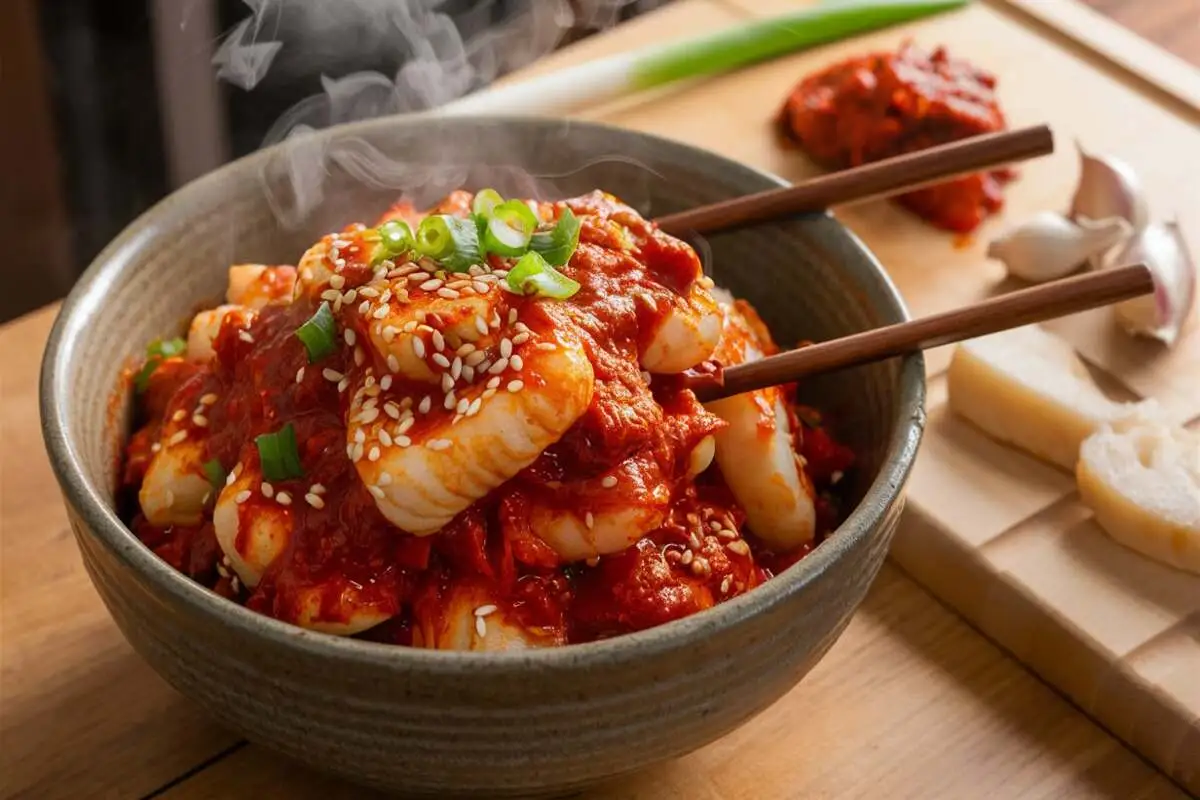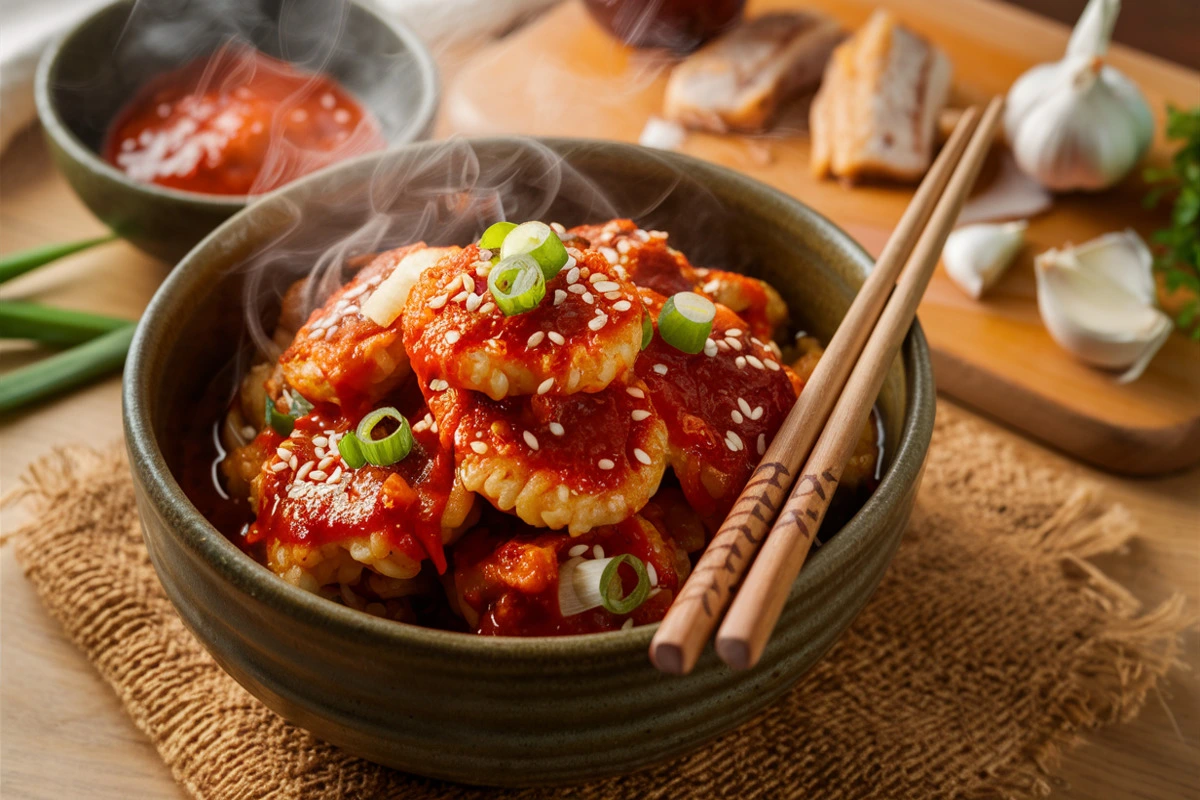Introduction to Tteokbokki Recipe
Tteokbokki is a beloved Korean street food known for its spicy and savory flavors. It has captured the hearts of food lovers around the world, becoming a popular dish both in Korea and internationally. This dish, primarily made from chewy rice cakes cooked in a spicy sauce, has deep cultural roots in Korea and is a staple in Korean cuisine.
Originating from the royal courts, Tteokbokki has evolved into a versatile dish with various adaptations that cater to different tastes. Whether you enjoy fiery heat or prefer something milder, this guide will provide you with everything you need to know to create the perfect Tteokbokki at home.
Explore the world of Korean cuisine and understand how Tteokbokki fits into the broader tapestry of Korean food traditions.
The Historical Background of Tteokbokki Recipe
Tteokbokki has a fascinating history that dates back several centuries. Originally known as Gungjung Tteokbokki (궁중떡볶이), which translates to “royal court rice cakes,” this dish was enjoyed by the Korean royalty during the Joseon Dynasty. Unlike the fiery red version popular today, Gungjung Tteokbokki was a savory dish made with soy sauce, vegetables, and meat. It was considered a luxurious food, symbolizing wealth and status.
The modern version of Tteokbokki that we know today, featuring the characteristic red chili sauce, emerged in the mid-20th century. This transformation is credited to a street vendor named Ma Bok-rim, who began selling tteok mixed with gochujang (Korean red chili paste) in Seoul’s Sindang-dong neighborhood. The dish quickly gained popularity and spread across Korea, becoming a staple of Korean street food culture.
Today, Tteokbokki is enjoyed by people of all ages and has become an iconic dish representing Korean culinary traditions. Whether served at a street stall, in a school cafeteria, or at a high-end restaurant, Tteokbokki remains a beloved comfort food that embodies the spirit of Korea.
Essential Ingredients for Tteokbokki Recipe
Creating authentic Tteokbokki starts with gathering the right ingredients:
- Rice Cakes (Tteok)
- The main ingredient, tteok are cylindrical rice cakes that provide the dish with its signature texture. You can find them at Korean grocery stores or make them at home.
- Gochujang (Korean Red Chili Paste)
- This is a key ingredient in the Tteokbokki sauce, offering the dish its characteristic heat and depth. If you can’t find gochujang, consider using alternative ingredients that can mimic its flavor profile.
- Additional Ingredients
- Fish cakes, green onions, garlic, and sugar are commonly used to balance the flavors. These ingredients add complexity to the dish, enhancing the taste and making each bite more enjoyable.
Nutritional Information Tteokbokki Recipe
Tteokbokki is a relatively calorie-dense dish due to the rice cakes, which are primarily made of glutinous rice flour. The dish provides a good amount of carbohydrates, making it an excellent energy source. However, it is important to note that Tteokbokki can be high in sugar and sodium, particularly if a lot of gochujang and soy sauce are used.
For those looking to make Tteokbokki healthier, consider the following tips:
- Reduce Sugar: Cut down on the sugar in the recipe, or use natural sweeteners like honey or agave syrup.
- Use Whole Grain Rice Cakes: Some stores offer whole grain or brown rice versions of tteok, which have more fiber and nutrients than the white rice variety.
- Add More Vegetables: Increase the amount of vegetables in the dish, such as carrots, cabbage, or bell peppers, to boost its nutritional content.
- Opt for Lean Protein: If adding meat or fish cakes, choose lean options to keep the dish lower in fat.
Traditional Tteokbokki Recipe

Here’s a step-by-step guide to making traditional Tteokbokki:
- Prepare the Rice Cakes
- Soak store-bought rice cakes in warm water for about 10 minutes to soften. If you’re using homemade rice cakes, ensure they are fresh and soft.
- Make the Broth
- In a pot, combine water with anchovy stock for an authentic Korean flavor. Bring it to a simmer.
- Create the Sauce
- Mix gochujang, gochugaru (Korean chili flakes), soy sauce, sugar, and minced garlic into the broth. Stir until the mixture is smooth and aromatic.
- Cook the Tteokbokki
- Add the rice cakes and fish cakes to the pot. Let them simmer in the sauce for 10-15 minutes, stirring occasionally until the rice cakes become soft and the sauce thickens.
- Garnish and Serve
- Top with sliced green onions and sesame seeds. Serve hot, possibly with additional sides like boiled eggs or kimchi.
Cooking Tips and Techniques
Making Tteokbokki can be straightforward, but there are a few tips and techniques that can help you achieve the best results:
- Consistency of the Sauce: The sauce is the heart of Tteokbokki, and getting the right consistency is key. The sauce should be thick enough to coat the rice cakes but not so thick that it becomes gluey. If your sauce is too thin, simmer it for a few more minutes. If it’s too thick, add a little more water or stock.
- Texture of the Rice Cakes: The texture of the rice cakes is another crucial aspect of the dish. They should be soft and chewy, not hard or mushy. If you’re using frozen rice cakes, make sure to soak them in warm water until they are fully thawed and pliable before cooking.
- Balancing Flavors: Tteokbokki is all about balancing sweet, spicy, and savory flavors. Taste the sauce as you cook, and adjust the seasoning as needed. You can add more sugar for sweetness, more soy sauce for umami, or more gochujang for heat.
Different Types of Tteokbokki
Tteokbokki comes in many variations, catering to different flavor preferences:
- Non-Spicy/Mild Tteokbokki
- This version uses soy sauce and broth instead of gochujang, making it a milder, savory option.
- Creamy/Carbonara Tteokbokki
- A modern twist that incorporates a creamy sauce, often with cheese, creating a rich and indulgent version of the dish. For inspiration, check out these creamy and cheesy variations.
- Jajang Tteokbokki (Black Bean Sauce)
- Combining the flavors of tteokbokki with jajangmyeon results in a delicious fusion dish with a savory black bean sauce.
- Cheesy Tteokbokki
- A popular variation where melted cheese is added to balance the spiciness with creamy goodness.
Regional Variations of Tteokbokki
While Tteokbokki is popular throughout Korea, different regions have their own unique takes on the dish:
- Sindang-dong Tteokbokki: Often considered the birthplace of modern Tteokbokki, Sindang-dong in Seoul is famous for its street vendors who serve a slightly sweeter and spicier version of the dish. This area has become a go-to destination for Tteokbokki lovers, with entire streets dedicated to this iconic dish.
- Busan Tteokbokki: In the coastal city of Busan, Tteokbokki is often made with seafood, reflecting the region’s rich maritime culture. This version might include squid, mussels, or shrimp, adding a briny depth to the traditional recipe.
- Jeolla Province Tteokbokki: Known for its rich and flavorful cuisine, Jeolla Province’s Tteokbokki is often spicier and more heavily seasoned than other versions. It might also include additional ingredients like perilla leaves or mushrooms, which are abundant in the region.
Modern Twists on Tteokbokki Recipe
Modern takes on Tteokbokki introduce creative twists that blend traditional Korean flavors with global influences:
- Fusion Tteokbokki
- Add ramen noodles or dumplings to make a heartier meal. The combination of chewy rice cakes and noodles creates a satisfying textural contrast.
- Healthier Alternatives
- Use whole grain or brown rice cakes for a more nutritious version. You can also make vegan Tteokbokki by using vegetable broth and omitting the fish cakes.
- Gourmet Tteokbokki: In upscale restaurants, Tteokbokki is sometimes served with premium ingredients like truffle oil, foie gras, or lobster. These gourmet versions elevate the dish, offering a unique blend of traditional and luxurious flavors.
Serving and Presentation Ideas

Presentation can enhance the enjoyment of Tteokbokki. Here are some serving tips:
- Traditional Serving Style
- Serve Tteokbokki in a hot stone bowl to keep it warm throughout the meal.
- Plating Ideas
- Arrange the rice cakes neatly, and garnish with sliced green onions and sesame seeds for a visually appealing dish.
- Side Dishes
- Pair with tangy deviled eggs or kimchi to complement the spicy flavors and add variety to your meal.
- Tteokbokki Bar: For a fun and interactive dining experience, set up a Tteokbokki bar where guests can customize their bowls with different toppings and sauces. This is a great option for parties or gatherings.
Frequently Asked Questions
- What can I use if I can’t find Gochujang?
- Substitute with a mix of red chili flakes, soy sauce, and a bit of sugar, though the flavor won’t be identical.
- Can I make Tteokbokki gluten-free?
- Yes, by using gluten-free rice cakes and tamari instead of soy sauce.
- How do I store leftovers, and how long do they last?
- Store in an airtight container in the fridge for up to 3 days. Reheat in a pan with a little water to revive the sauce.
- Is Tteokbokki healthy?
- It can be, depending on the ingredients. Use less sugar and healthier rice cakes for a more nutritious version.
- What’s the difference between Tteokbokki and Tteokguk?
- Tteokguk is a soup made with sliced rice cakes, traditionally eaten on Korean New Year’s Day, while Tteokbokki is a spicy, stir-fried dish.
The Cultural Significance of Tteokbokki Recipe
Beyond its delightful taste, Tteokbokki holds a special place in Korean culture. It is a dish that is often associated with memories of school days, as it is commonly sold at snack stands near schools. For many Koreans, the taste of Tteokbokki evokes a sense of nostalgia and comfort, reminiscent of simpler times.
In recent years, Tteokbokki has also become a symbol of hallyu, or the Korean wave, spreading Korean culture around the world. The dish is frequently featured in Korean dramas, movies, and variety shows, contributing to its growing popularity overseas.
Tteokbokki is also a dish that brings people together. Whether shared among friends at a street stall or enjoyed at home with family, it fosters a sense of community and togetherness. It’s not just food; it’s a cultural experience that transcends borders.
Conclusion and Final Tips

Making Tteokbokki at home is a delightful way to explore the rich flavors of Korean cuisine. Whether you stick to the traditional recipe or experiment with modern variations, the key is to enjoy the cooking process and savor each bite.
Pair your Tteokbokki with a juicy and flavorful smoked meatloaf for a hearty meal that brings together the best of different culinary traditions.
As you experiment with different ingredients and techniques, you’ll find that Tteokbokki is a versatile dish that can be adapted to suit a variety of tastes and occasions. Whether you’re cooking for yourself, your family, or a group of friends, Tteokbokki is sure to be a hit.

